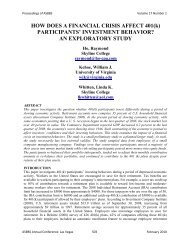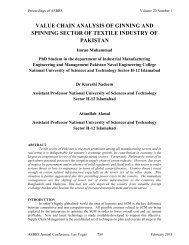stock repurchase announcements: a test of market ... - Asbbs.org
stock repurchase announcements: a test of market ... - Asbbs.org
stock repurchase announcements: a test of market ... - Asbbs.org
You also want an ePaper? Increase the reach of your titles
YUMPU automatically turns print PDFs into web optimized ePapers that Google loves.
Along with the focus on productivity is greater emphasis on the bottom line. Facilities cost<br />
money to configure and maintain and may be difficult to evolve or scale as the institution<br />
evolves. A home <strong>of</strong>fice makes it easy to get to work, meaning more work may be done over a<br />
day since employees can readily access their computing environment. The virtual <strong>of</strong>fice space<br />
enables the <strong>of</strong>fice to be readily available nearly anywhere the faculty member travels. In<br />
addition, the stress and cost associated with the commute are eliminated. One <strong>of</strong> the key savings<br />
to faculty is in the form <strong>of</strong> decreased travel and gasoline expenses. With the high costs <strong>of</strong> fuel,<br />
such savings represent a major portion <strong>of</strong> the family budget. The savings at the institutional level<br />
would ideally be passed on the student in the form <strong>of</strong> limited increases in tuition and fees.<br />
Collegiality: Collegiality can be defined as respect for one’s colleagues and for their pr<strong>of</strong>essional<br />
endeavors (Kouchokos, 2002). The American Association <strong>of</strong> University Pr<strong>of</strong>essors (1999)<br />
describes collegiality as collaboration and constructive cooperation but not as a distinct capacity<br />
to be assessed independently <strong>of</strong> scholarship, teaching, and service. There are countless<br />
opportunities for collaboration and constructive cooperation within the virtual <strong>of</strong>fice environment<br />
with limited barriers for communication across the globe. This is not always the case within the<br />
onsite <strong>of</strong>fice where fellow faculty members and students are <strong>of</strong>ten in different buildings, or<br />
campuses, and thus too far away for the ease <strong>of</strong> face-to-face communications. Within the virtual<br />
<strong>of</strong>fice, faculty may communicate via e-mail, group or individual online chats, and interact in<br />
virtual meeting rooms, common within the virtual <strong>of</strong>fice setting. Increased interaction brings<br />
added opportunities for faculty to support one another toward enhanced collegiality.<br />
An additional component <strong>of</strong> collegiality is highlighted by Neal (1996) in his statement to new<br />
faculty. Neal encourages faculty members to involve students in collegial relationships in ways<br />
that bring them into the intellectual community as research partners. Neal asserts that collegiality<br />
is a rare but precious commodity among faculty who are committed to the world <strong>of</strong> ideas and who<br />
are involved in the creative sharing and exchange <strong>of</strong> information. The virtual <strong>of</strong>fice space<br />
enables this type <strong>of</strong> information sharing to be possible where faculty, students, and graduates<br />
collaborate without physical barriers.<br />
Human Resources: Recruiting a qualified diverse group <strong>of</strong> faculty may be easier to accomplish<br />
when the expectations placed on faculty do no include onsite <strong>of</strong>fice hours. Faculty may be more<br />
likely to consider working for an institution located out <strong>of</strong> state or in another country when the<br />
expectations do not include physical relocation. Faculty training and orientation is yet another<br />
key aspect for human resource pr<strong>of</strong>essionals seeking to recruit and retain qualified faculty. In a<br />
centralized <strong>of</strong>fice, training is usually accomplished by bringing a group <strong>of</strong> new faculty members<br />
to an on campus meeting place. Videoconferencing provides a reasonable alternative for training<br />
faculty who work in a virtual <strong>of</strong>fice setting. As with any employee, the needs <strong>of</strong> the family<br />
members are paramount. Unfortunately, far too many faculty leave institutions after years <strong>of</strong><br />
dedicated service due to personal and family circumstances and the need to relocate away from<br />
the geographic proximity <strong>of</strong> the institution. This creates higher faculty turnover rates and<br />
associated costs. Ultimately the institution thrives when a more diverse group <strong>of</strong> faculty are<br />
recruited, oriented, and retained.<br />
Student Learning Needs: Faculty can promote student-faculty contact within the virtual <strong>of</strong>fice<br />
environment by building communication mechanisms into the course and by encouraging<br />
students to make frequent visits to the virtual <strong>of</strong>fice. Such practices ultimately lead to enhanced<br />
student learning. Chickering and Gamson (1999) discuss the seven principles for good practice in<br />
undergraduate education. Faculty members who function within a virtual <strong>of</strong>fice environment have<br />
ample opportunities through e-mail, phone calls, online group discussions and videoconferencing<br />
Virtual Office<br />
ASBBS E-Journal, Volume 4, No.1, 2008 14

















